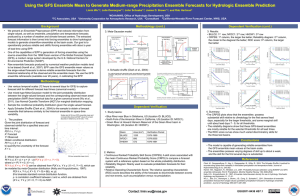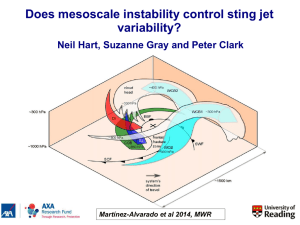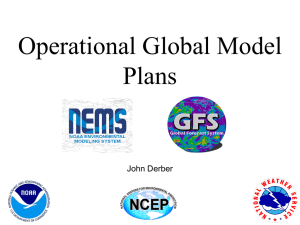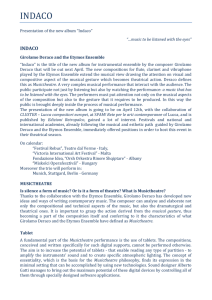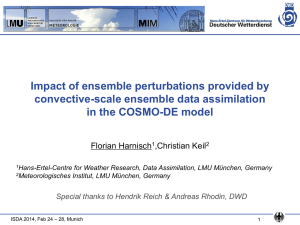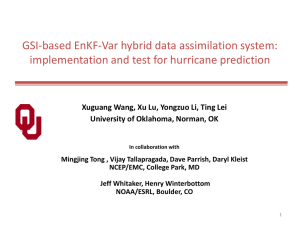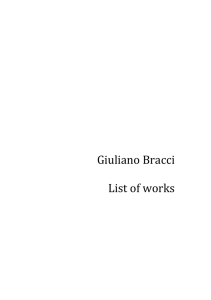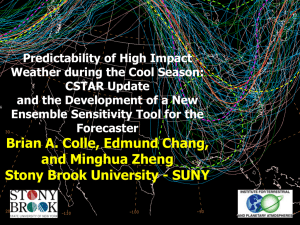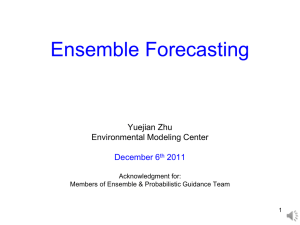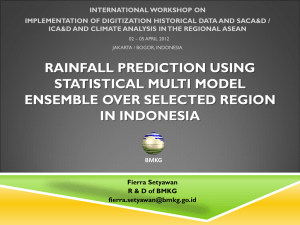Quantifying and representing uncertainty in - ESA
advertisement
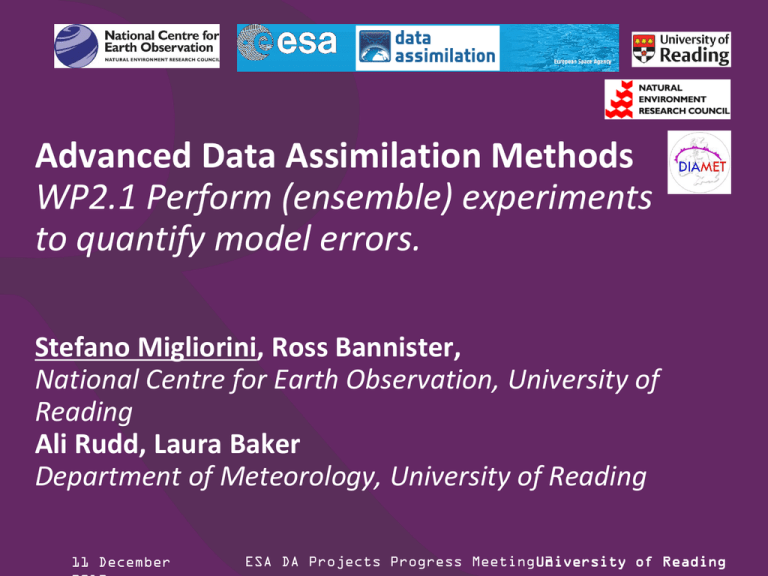
Advanced Data Assimilation Methods WP2.1 Perform (ensemble) experiments to quantify model errors. Stefano Migliorini, Ross Bannister, National Centre for Earth Observation, University of Reading Ali Rudd, Laura Baker Department of Meteorology, University of Reading 11 December ESA DA Projects Progress MeetingUniversity 2 of Reading Motivation • Satellite observations form the vast majority of the total number of observations assimilated in NWP models. • To exploit information from satellite (as well as in-situ) instruments, prior knowledge from NWP forecasts is needed (Bayesian approach). • Climatology of forecast errors at larger scales reflects wellknown balance relationships of atmospheric flow. • Structure of high-res forecast errors are much more uncertain. • Aim of this work is to provide reliable estimates of forecast errors at convective scale (new generation models) to improve assimilation of in-situ, radar and satellite data. Aims of the project • Investigate sources of uncertainty in high-res forecasts: – Initial and boundary condition errors. – Model errors due to the parameterisation of subgrid-scale processes. • Use a convective-scale ensemble prediction system (EPS). • Evaluate the effects of these errors on the forecast error covariances. • Check reliability of errors using observations. • Improve our knowledge of high-res forecast errors and of their balance relationships for better high-res DA. Case Study: 20 September 2011 • DIAMET IOP2 – flight campaign case. • Frontal wave structure. • SW-NE flow across southern UK. 1200UTC analysis • Interesting banded structure in radar not captured in the 1800UTC analysis operational 1.5km forecast or our control forecast. Ensemble system UK Met Office operational ensemble systems MOGREPS: Met Office Global and Regional Ensemble Prediction System: MOGREPS-G •MOGREPS-G: 60 km grid spacing, 70 vertical levels. •MOGREPS-R: 18 km grid spacing, 70 vertical levels. MOGREPS-R •23 perturbed members and one control member. •(MOGREPS-UK: 2.2km grid spacing, 12member ensemble). Figure source: J.F. Caron MOGREPS-G 1.5 km domain MOGREPS-R 07 08 09 10 11 12 13 14 15 16 17 18 6hr forecast • Domain over southern UK (360 x 288 grid points). • Control member from 3D-Var analysis. • 23 perturbed members: initial condition perturbations and LBCs from MOGREPS-R. • Hourly-cycling ETKF for the first 6 hours. • 6 hour forecast from 12Z. Figure source: J.F. Caron Simulating model error: the Random Parameter scheme Has been used operationally in MOGREPS. Not used previously in a convective-scale EPS. RP treats a set of parameters in various parametrization schemes as stochastic variables. Applies different random perturbations to these parameters for each ensemble member. Based on first-order auto-regression model (Pt is the parameter value at time t): Pt = μ + r (Pt-1 – μ) + ε μ is the default value of the parameter. r = 0.95 is the auto-correlation coefficient of P. ε is the stochastic shock term (random value in range ± (Pmax – Pmin) / 3). Pmax, Pmin for each parameter are estimated by experts. Have studied forecast sensitivities to each parameter. Options to how RP can be applied: CTL: Parameters set the same between members (ics only). RP-60: Update every 60 minutes. RP-30: Update every 30 minutes. RP-fix: Parameters set at t = 0 only. onlyRP: RP-60\30\fix without ic. Sensitivity to perturbed parameters RMS difference between perturbed and control forecasts at T+3 (1500 UTC) 1.5m temperature 10m uwind Ensemble experiments Ensemble name Description Model error variability IC and LBC variability Inflation CTL Control No Yes Yes IC+BC+RPfix RP scheme with fixed params Yes Yes Yes IC+BC+RP30 RP scheme with 30 minute update Yes Yes Yes IC+BC+RP60 RP scheme with 60 minute update Yes Yes Yes RPfix ME only: RP scheme with fixed params Yes No Yes RP30 ME only: RP scheme with 30 minute update Yes No Yes RP60 ME only: RP scheme with 60 minute update Yes No Yes How does model error affect the spread? 1.5m temperature 10m wind speed ___ control ensemble ___ ensemble with fixed perturbed parameters Domain-averaged ensemble spread: n points 1 variancei n-points i 1 Hourly rainfall accumulation How does model error affect the spread? 1.5m temperature 10m wind speed ___ control ensemble ___ ensemble with fixed perturbed parameters ___ ensemble with periodic update (30 min) ___ ensemble with periodic update (60 min) Domain-averaged ensemble spread: n points 1 variancei n-points i 1 Hourly rainfall accumulation How does model error affect the spread? 1.5m temperature 10m wind speed Hourly rainfall accumulation ___ control ensemble ___ ensemble with fixed perturbed parameters ___ ensemble with periodic update (30 min) ___ ensemble with periodic update (60 min) - - - model error only (fixed parameters) - - - model error only (30 min) - - - model error only (60 min) How does model error affect the forecast skill? ___ control ensemble ___ ensemble with fixed perturbed parameters ___ ensemble with periodic update (30 min) ___ ensemble with periodic update (60 min) Better skill - Continous ranked probability score. - Comparison of CDF of forecast and obs. rain accumulation u-wind component v-wind component Better skill CRPS: surface temperature How does model error affect the forecast skill? Precipitation skill score for hourly rainfall accumulation Threshold of 0.2 mm Threshold of 1.0 mm Better skill Threshold of 0 mm ___ control ensemble ___ ensemble with fixed perturbed parameters Precipitation skill score: BSens PSSens 1 BScontrol How does model error affect the forecast skill? Precipitation skill score for hourly rainfall accumulation Threshold of 0 mm Threshold of 0.2 mm ___ control ensemble ___ ensemble with fixed perturbed parameters ___ ensemble with periodic update (30 min) ___ ensemble with periodic update (60 min) Threshold of 1.0 mm Precipitation skill score: BSens PSSens 1 BScontrol Summary • Developing a method of representing model error in a convective scale ensemble: – Random parameters scheme. • How does the additional representation of model error affect the spread of the ensemble? – Temperature and wind speed – applying the RP scheme increases the spread. – Rainfall rate – the RP scheme has an undesirable peaks in the spread – this is reduced by keeping parameters fixed. • How does model error affect the forecast skill? – Small effect on forecast skill. – Skill in rain rate and accumulation is reduced – probably due to reduction in total rain rate. Forecast errors in data assimilation • q-w correlations > 0. • The more buoyant the parcel the wetter. • Descent leads to warmer and drier parcels. Conclusions • Including model error variability increases ensemble spread in most quantities, over and above that found from ensembles that include only initial condition and lateral boundary condition variability. • Including model error variability is not guaranteed to increase ensemble spread in all quantities, e.g. we have found that the spread of rainfall forecasts is actually reduced, although it is not clear why this is so. • Ensemble forecasts can inform data assimilation studies of the correct structure of forecast error statistics and the balances that are obeyed. • Future work includes investigations on covariance length scales, study of forecast errors using observations and effects of sampling errors. Extra slides Do any of the ensemble members capture the banding in the rain? “stamp plot” Ensemble: RP scheme on - with model error 1500 UTC Parameters in our modified RP scheme • • • Parameters above the black line are in the existing scheme; those below are new We vary some parameters together where appropriate (eg. ei and eic; x1r, x1i and x1ic) – i.e. we use the same random seed for ei and eic so that they vary together rather than independently We have found that the particle size distribution parameters (x1r, etc.) have a larger effect than any others – possibly too large

